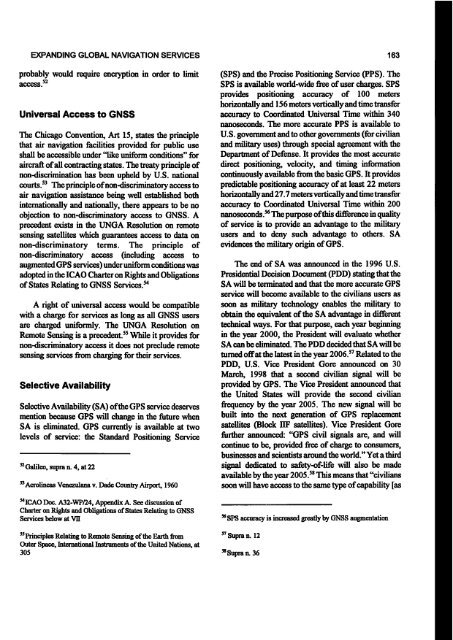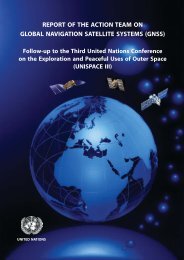Proceedings of the Workshop - United Nations Office for Outer ...
Proceedings of the Workshop - United Nations Office for Outer ...
Proceedings of the Workshop - United Nations Office for Outer ...
- No tags were found...
You also want an ePaper? Increase the reach of your titles
YUMPU automatically turns print PDFs into web optimized ePapers that Google loves.
EXPANDING GLOBAL NAVIGATION SERVICESprobably would require encryption in order to limitaccess.52Universal Access to GNSSThe Chicago Convention, Art 15, states <strong>the</strong> principlethat air navigation facilities provided <strong>for</strong> public useshall be accessible under “like uni<strong>for</strong>m conditions” <strong>for</strong>aircraft <strong>of</strong> all contracting states. The treaty principle <strong>of</strong>non-discrimination has been upheld by U.S. nationalcourts.33 The principle <strong>of</strong> non-discriminatory access toair navigation assistance being well established bothinternationally and nationally, <strong>the</strong>re appears to be noobjection to non-discriminatory access to GNSS. Aprecedent exists in <strong>the</strong> UNGA Resolution on remotesensing satellites which guarantees access to data onnon-discriminatory terms. The principle <strong>of</strong>non-discriminatory access (including access toaugmented GPS services) under uni<strong>for</strong>m conditions wasadopted in <strong>the</strong> ICAO Charter on Rights and Obligations<strong>of</strong> States Relating to GNSS Services.54A right <strong>of</strong> universal access would be compatiblewith a charge <strong>for</strong> services as long as all GNSS usersare charged uni<strong>for</strong>mly. The UNGA Resolution onRemote Sensing is a precedent.55 While it provides <strong>for</strong>non-discriminatory access it does not preclude remotesensing services from charging <strong>for</strong> <strong>the</strong>ir services.Selective AvailabilitySelective Availability (SA) <strong>of</strong> <strong>the</strong> GPS service deservesmention because GPS will change in <strong>the</strong> future whenSA is eliminated. GPS currently is available at twolevels <strong>of</strong> service: <strong>the</strong> Standard Positioning Service52 Galileo, supra n. 4, at 22“ Aerolineas Venezulana v. Dade Country Airport, 196054 ICAO Doc. A32-WP/24, Appendix A. See discussion <strong>of</strong>Charter on Rights and Obligations <strong>of</strong> States Relating to GNSSServices below at VII55 Principles Relating to Remote Sensing <strong>of</strong> <strong>the</strong> Earth from<strong>Outer</strong> Space, International Instruments <strong>of</strong> <strong>the</strong> <strong>United</strong> <strong>Nations</strong>, at305163(SPS) and <strong>the</strong> Precise Positioning Service (PPS). TheSPS is available world-wide free <strong>of</strong> user charges. SPSprovides positioning accuracy <strong>of</strong> 100 metershorizontally and 156 meters vertically and time transferaccuracy to Coordinated Universal Time within 340nanoseconds. The more accurate PPS is available toU.S. government and to o<strong>the</strong>r governments (<strong>for</strong> civilianand military uses) through special agreement with <strong>the</strong>Department <strong>of</strong> Defense. It provides <strong>the</strong> most accuratedirect positioning, velocity, and timing in<strong>for</strong>mationcontinuously available from <strong>the</strong> basic GPS. It providespredictable positioning accuracy <strong>of</strong> at least 2 2 metershorizontally and 27.7 meters vertically and time transferaccuracy to Coordinated Universal Time within 200nanoseconds.56 The purpose <strong>of</strong> this difference in quality<strong>of</strong> service is to provide an advantage to <strong>the</strong> militaryusers and to deny such advantage to o<strong>the</strong>rs. SAevidences <strong>the</strong> military origin <strong>of</strong> GPS.The end <strong>of</strong> SA was announced in <strong>the</strong> 1996 U.S.Presidential Decision Document (PDD) stating that <strong>the</strong>SA will be terminated and that <strong>the</strong> more accurate GPSservice will become available to <strong>the</strong> civilians users assoon as military technology enables <strong>the</strong> military toobtain <strong>the</strong> equivalent <strong>of</strong> <strong>the</strong> SA advantage in differenttechnical ways. For that purpose, each year beginningin <strong>the</strong> year 2000, <strong>the</strong> President will evaluate whe<strong>the</strong>rSA can be eliminated. The PDD decided that SA will beturned <strong>of</strong>f at <strong>the</strong> latest in <strong>the</strong> year 2006.57 Related to <strong>the</strong>PDD, U.S. Vice President Gore announced on 30March, 1998 that a second civilian signal will beprovided by GPS. The Vice President announced that<strong>the</strong> <strong>United</strong> States will provide <strong>the</strong> second civilianfrequency by <strong>the</strong> year 2005. The new signal will bebuilt into <strong>the</strong> next generation <strong>of</strong> GPS replacementsatellites (Block IIF satellites). Vice President Gorefur<strong>the</strong>r announced: “GPS civil signals are, and willcontinue to be, provided free <strong>of</strong> charge to consumers,businesses and scientists around <strong>the</strong> world.” Yet a thirdsignal dedicated to safety-<strong>of</strong>-life will also be madeavailable by <strong>the</strong> year 2005,58 This means that “civilianssoon will have access to <strong>the</strong> same type <strong>of</strong> capability [as56 SPS accuracy is increased greatly by GNSS augmentation57 Supra n. 1258 Supra n. 36
















